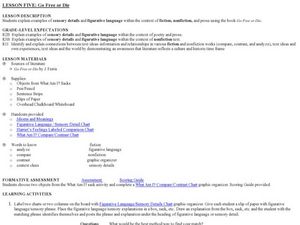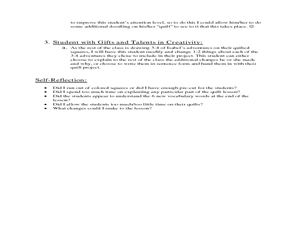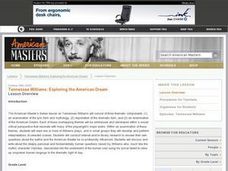Curated OER
Historical Agency in History Book Sets (HBS)
Study historical events by combining the study of historical fiction and non-fiction. Learners read about true past events in historical fiction novels and then research non-fiction accounts of the same events. What are some differences...
Curated OER
Go Free or Die: Figurative Language
Figures of speech, sensory details, and academic language are all targeted while reading Chapter Two of J. Ferris’ Go Free or Die. First, learners engage in an exercise to practice describing with detail. Then, partners use a chart to...
Curated OER
LPS Nonfiction and Research Follow-Up CRT Project
Students read different types of literature in a group setting. They discuss the related themes and research them. They create a PowerPoint presentation on the information they have collected.
Curated OER
Let's Sum It Up
Students summarize a selected piece of nonfiction text as a group. After reviewing the instructors preferred method for summarizing information by identifying the main idea and supporting details, groups write a summary paragraph of a...
Curated OER
Time to Read
Students identify how the literary elements of theme, point of view, characterization, setting, and plot illustrate the effects of a certain disease on a community. They identify the aspects of the book that are specific to the...
Curated OER
Analyzing Textbook Formats
Students explore the characteristics of a non-fiction text. For this comprehension lesson, students are led on a guided tour of each text and identify the features of a non-fiction text. Students continue to practice locating features...
Curated OER
Comprehension-Note Taking Skills to Supprt Opinions and Panel Discussion
Fifth graders examine note taking skills in order to support opinions. In this language arts lesson, 5th graders read several newpaper articles and discuss a current issue. Students explore how to paraphrase so as not to commit plagiarism.
Curated OER
Making Predictions by Analyzing Key Ideas and Details
Young scholars make predictions. In this language arts instructional activity, students read nonfiction texts and make predictions about what they are going to read. Young scholars confirm and revise their predictions as they read the text.
Curated OER
Go For The Gold!
Third graders read fiction and nonfiction works for comprehension. Using the internet, 3rd graders participate in a WebQuest. They compare and contrast the Olympics in ancient Greece to the modern day Olympics. Afterwards, students...
Curated OER
The Gray Wolf Story Pyramid
Students explore comprehension and understanding of what they read. They practice using the correct spelling for frequently used sight words and uncommon words. Students apply the correct principles of grammar. They read the article Gray...
Curated OER
Patchwork Adventure Poetry
Third graders explore poetry by completing a worksheet. In this poetry instructional activity, 3rd graders create a quilt using images students have drawn based on imagery. Students practice using vocabulary from the poem "Adventures...
Curated OER
Real and Fictional Wolves
Students demonstrate understanding of the difference between real and fictional wolves through critical reading and comparisons while using a Venn Diagram.
Curated OER
Can You Get the Signal?
What is a signal word? Recognizing these words is an important step in both reading and writing formal text. Review a list of signal words (provided and organized into specific categories), and then have your class play a game to...
Curated OER
In the Eye of the Tiger
Young scholars read about tigers in both fiction and nonfiction, poetry and prose. They study tiger markings in photographs of living tigers to create a sculptural mask reflecting their knowledge of tiger markings. Afterward, they write...
Curated OER
Summarize What You Read
Third graders summarize a selected piece of nonfiction text. After reviewing the correct way to use a Venn diagram, 3rd graders read a nonfiction article. They write a summary paragraph using their Venn Diagram and the five-step process...
Curated OER
Literacy:Non-Fiction Stories
Third graders explore non-fiction stories. They follow along as the teacher reads a story. Students fill in words as the teacher reads to ensure they are following along. They discuss the text features found in the book and the features...
Curated OER
Establish the Theme
Second graders explore the topic of nature. In this detective lesson, 2nd graders review non-fiction materials on nature and identify text, headings, diagrams, graphs, to establish the theme of the book.
Curated OER
Introducing Working Animals
Students identify ways humans and animals work together. In this animal welfare lesson, students read the text Hanni and Beth: Safe and Sound and define the term "working animals." Students investigate working animals by visiting various...
Curated OER
Jane Goodall
Learners read about Jane Goodall and complete discussion questions after they read about her. In this Jane Goodall lesson plan, students discuss questions as a group or write answers individually.
Curated OER
Deduction
Students investigate the linguistic devices used by writers to create meaning. In this writing instructional activity, students discover why writers write in different ways showing examples of different types of text. After reading each...
Curated OER
Cinderella Stories
Students read and compare Cinderella stories using a worksheet. They write and illustrate original tales with a twist.
Curated OER
Tennessee Williams: Exploring the American Dream
Young scholars read and analyze selections of Tennessee Williams' work. They write journal responses, conduct Internet research, perform various scenes from one of Williams' dramas, and create a presentation.
Curated OER
Activity Plan Mixed Ages: Do the Animal Dance!
Students create a dance based on animal movements. In this kinesthetic lesson plan, the students will read and imitate animals in a creative way and share their dances with the group. The lesson includes a take-home activity and a math...
Curated OER
Nocturnal vs. Diurnal Animals
First graders identify nocturnal and diurnal animals. In this animal lesson, 1st graders discuss the differences between animals that are active during the day and those that are active at night. Students write summaries about their...

























